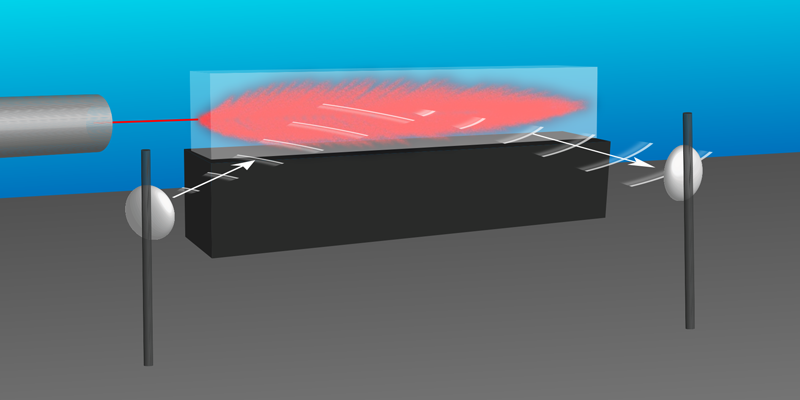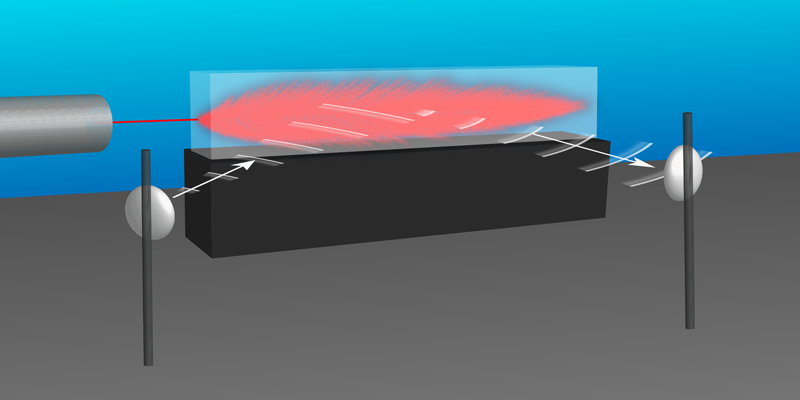Catching Neutrinos on Radar
High-energy particles from space carry hints about the violent astrophysical events that created them. Now researchers have demonstrated the feasibility of a method for detecting cosmic neutrinos when their energies are between 10 and 100 peta-electron-volts—an energy blind spot for existing detection methods. The technique involves bouncing radio waves off a cloud of electrical charge created in a material after the passage of a high-energy neutrino, although the experiment used an intense pulse of electrons to mimic the cosmic particle. The method should help astrophysicists better understand the events that produce the most energetic neutrinos.
Ultrahigh-energy cosmic rays—energetic protons and nuclei from space—are one of the great mysteries of astrophysics because researchers don’t know where they come from. The events that produce them ought to create neutrinos as well, and observing neutrinos has the advantage that the particles almost never interact with other matter and so travel along straight lines, thereby giving the direction to their point of origin. Researchers can already detect neutrinos within certain energy ranges. For example, the IceCube Neutrino Observatory in Antarctica detects neutrinos with energies in the range of tera-electron-volts (TeV) to peta-electron-volts (PeV), which corresponds to – eV. Other techniques should work well for neutrinos of extremely high energy, well over 100 PeV. A detection gap, however, has remained in the range of 10 – 100 PeV.
Such a neutrino moving through solid matter will sometimes create a shower of fast-moving charged particles called a cascade. As these particles slow down, they ionize atoms in the solid, leaving behind a tell-tale cloud of electrical charge. A team led by Steven Prohira of Ohio State University in Columbus has now shown that the neutrino might be detected by observing this charged cloud. To demonstrate the principle, they used a steady source of electron pulses, rather than waiting for the occasional, high-energy cosmic neutrino to strike their experiment.
Using an electron beam at the SLAC National Accelerator Lab in California, the researchers directed intense bursts of high-energy electrons at a 4-m-long target made of high-density polyethylene (a plastic). The team chose the electron energies so that the resulting cascades—one created by each burst of electrons—would have a particle density much like that expected for a high-energy neutrino hitting the Earth.
The researchers sent radio waves continuously toward the target in a direction perpendicular to the electron beam. The ionization cloud created by each cascade was expected to reflect waves back to a receiving antenna, providing information in the same way that radar reflections do. But detecting these cascades required careful data analysis, because the mere passage of the dense electron beam through the target generates radio waves some 10 to 100 times stronger than any reflection from a cascade event.
In preliminary experiments, the team measured the radio waves created by the electron beam alone—with the radar transmitter turned off—and found them to be consistent from one pulse to the next. They could then subtract this background radiation from the full radio signal they measured with the transmitter turned on to find the evidence of cascades.
“The most important achievement,” says Prohira, “is that we were able to measure radar echoes off of individual particle cascades. This has never been done before.” Francis Halzen of the University of Wisconsin, Madison, director of IceCube, is impressed. “It is great to see a successful demonstration of the basic [radar] echo technique,” he says. Earlier neutrino detector projects also relied on SLAC electron beams for proof-of-principle demonstrations of their basic setups, giving researchers “confidence that the science was totally understood,” says Halzen. “This research has achieved much the same thing.”
In practice, Prohira says, this new technique would operate with Antarctic ice playing the role of the plastic target. Using a detector embedded deeply within the ice, any cascade could be reliably interpreted as being caused by neutrinos, since no other particle type could reach such a depth. “Our next step is to test it out in nature,” says Prohira, “to see if our lab results translate to the real thing.”
This research is published in Physical Review Letters.
–Mark Buchanan
Mark Buchanan is a freelance science writer who splits his time between Abergavenny, UK, and Notre Dame de Courson, France.





